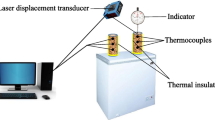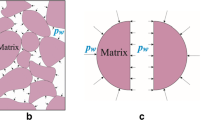Abstract
Roads are exposed to various degradation mechanisms during their lifetime. The pavement deterioration caused by the surrounding environment is particularly severe in winter when the humidity and subfreezing temperatures prevail. Frost heave-induced damage is one of the winter-related pavement deterioration. It occurs when the porewater in the soil is exposed to freezing temperatures. The study of frost heave requires conducting a multiphysics analysis, considering the thermal, mechanical, and hydraulic fields. This paper presents the use of a coupled thermo-mechanical approach to simulate frost heave in saturated soils. A function predicting porosity evolution is implemented to couple the thermal and mechanical field analyses. This function indirectly considers the effect of the water seepage inside the soil. Different frost heave scenarios with uniform and non-uniform boundary conditions are considered to demonstrate the capabilities of the method. The results of the simulations indicate that the thermo-mechanical model captures various processes involved in the frost heave phenomenon, such as water fusion, porosity variation, cryogenic suction force generation, and soil expansion. The characteristics and consequences of each process are determined and discussed separately. Furthermore, the results show that non-uniform thermal boundaries and presence of a culvert inside the soil result in uneven ground surface deformations.
Similar content being viewed by others
References
Chen X, Shi D. Influence of freeze-thaw cycles on apparent dynamic tensile strength, apparent dynamic fracture toughness and microstructure of concrete under impact loading. European Journal of Environmental and Civil Engineering, 2019, 25(11): 1977–2001
Sylvestre O, Bilodeau J P, Doré G. Effect of frost heave on long-term roughness deterioration of flexible pavement structures. International Journal of Pavement Engineering, 2019, 20(6): 704–713
Sun B, Yang Y, Li X, Yan M, Xie M, Bao Y. Full-scale investigation of post-tensioned prestressed concrete bridge girders subjected to frost heaving in cold regions. Engineering Structures, 2022, 250: 113413
Taber S. Frost heaving. Journal of Geology, 1929, 37(5): 428–461
Mitchell J K. Fundamentals of the Soil Behavior. New York: John Wiley & Sons, 1976
Takagi S. Segregation freezing as the cause of suction force for ice lens formation. Engineering Geology, 1979, 13(1–4): 93–100
Wilen L A, Dash J G. Frost heave dynamics at a single crystal interface. Physical Review Letters, 1995, 74(25): 5076–5079
Rempel A W, Wettlaufer J S, Worster M G. Interfacial premelting and the thermomolecular force: Thermodynamic buoyancy. Physical Review Letters, 2001, 87(8): 088501
Dagli D. Laboratory Investigations of Frost Action Mechanisms in Soils. Luleå: Luleå University of Technology, 2017
Chamberlain E J. Frost Susceptibility of Soil, Review of Index Tests. Hanover: Cold Regions Research and Engineering Lab, 1981
Takashi T, Yamamoto H, Ohrai T, Masuda M. Effect of penetration rate of freezing and confining stress on the frost heave ratio of soil. In: Proceedings of the 3rd International Conference on Permafrost. Ottawa: National Research Council of Canada, 1978
Zheng H, Kanie S. Combined thermal-hydraulic-mechanical frost heave model based on Takashi’s equation. Journal of Cold Regions Engineering, 2015, 29(4): 04014019
Konrad J M, Morgenstern N R. The segregation potential of a freezing soil. Canadian Geotechnical Journal, 1981, 18(4): 482–491
Konrad J M, Morgenstern N R. Frost heave prediction of chilled pipelines buried in unfrozen soils. Canadian Geotechnical Journal, 1984, 21(1): 100–115
O’Neill K, Miller R D. Exploration of a rigid ice model of frost heave. Water Resources Research, 1985, 21(3): 281–296
Michalowski R L. A constitutive model of saturated soils for frost heave simulations. Cold Regions Science and Technology, 1993, 22(1): 47–63
Michalowski R L, Zhu M. Frost heave modeling using porosity rate function. International Journal for Numerical and Analytical Methods in Geomechanics, 2006, 30(8): 703–722
Li N, Chen B, Chen F, Xu X. The coupled heat-moisture-mechanic model of the frozen soil. Cold Regions Science and Technology, 2000, 31(3): 199–205
Li N, Chen F, Su B, Cheng G. Theoretical frame of the saturated freezing soil. Cold Regions Science and Technology, 2002, 35(2): 73–80
Li N, Chen F, Xu B, Swoboda G. Theoretical modeling framework for an unsaturated freezing soil. Cold Regions Science and Technology, 2008, 54(1): 19–35
Nishimura S, Gens A, Olivella S, Jardine R J. THM-coupled finite element analysis of frozen soil: Formulation and application. Geotechnique, 2009, 59(3): 159–171
Liu Z, Yu X. Coupled thermo-hydro-mechanical model for porous materials under frost action. Acta Geotechnica, 2011, 6(2): 51–65
Zhou J, Li D. Numerical analysis of coupled water, heat and stress in saturated freezing soil. Cold Regions Science and Technology, 2012, 72: 43–49
Yin X, Liu E, Song B, Zhang D. Numerical analysis of coupled liquid water, vapor, stress and heat transport in unsaturated freezing soil. Cold Regions Science and Technology, 2018, 155: 20–28
Weng X, Sun Y, Yang Z, Wang D, Yu H. A thermal-hydromechanical coupled model for poro-viscoplastic saturated freezing soil. European Journal of Environmental and Civil Engineering, 2020, 26(9): 4220–4236
Lai Y, Pei W, Zhang M, Zhou J. Study on theory model of hydro-thermal-mechanical interaction process in saturated freezing silty soil. International Journal of Heat and Mass Transfer, 2014, 78: 805–819
Zhang Y, Michalowski R L. Thermal-hydro-mechanical analysis of frost heave and thaw settlement. Journal of Geotechnical and Geoenvironmental Engineering, 2015, 141(7): 04015027
Çengel Y A. Heat and Mass Transfer: A Practical Approach. New York: McGraw-Hill, 2007
Hohmann M. Soil freezing—The concept of soil water potential. State of the art. Cold Regions Science and Technology, 1997, 25(2): 101–110
Bower A. Applied Mechanics of Solids. Boca Raton: CRC Press, 2009
Vu-Bac N, Duong T X, Lahmer T, Areias P, Sauer R A, Park H S, Rabczuk T. A NURBS-based inverse analysis of thermal expansion induced morphing of thin shells. Computer Methods in Applied Mechanics and Engineering, 2019, 350: 480–510
Vu-Bac N, Rabczuk T, Park H S, Fu X, Zhuang X. A NURBS-based inverse analysis of swelling induced morphing of thin stimuli-responsive polymer gels. Computer Methods in Applied Mechanics and Engineering, 2022, 397: 115049
Areias P, Vu-Bac N, Rabczuk T. A multisurface constitutive model for highly cross-linked polymers with yield data obtained from molecular dynamics simulations. International Journal of Mechanics and Materials in Design, 2018, 14(1): 21–36
Ren J, Vanapalli S K, Han Z. Soil freezing process and different expressions for the soil-freezing characteristic curve. Sciences in Cold and Arid Regions, 2018, 9(3): 221–228
Koopmans R W R, Miller R D. Soil freezing and soil water characteristic curves. Soil Science Society of America Journal, 1966, 30(6): 680–685
Kurylyk B L, Watanabe K. The mathematical representation of freezing and thawing processes in variably-saturated, non-deformable soils. Advances in Water Resources, 2013, 60: 160–177
van Genuchten M T. A closed-form equation for predicting the hydraulic conductivity of unsaturated soils. Soil Science Society of America Journal, 1980, 44(5): 892–898
Moberg A. Stockholm Historical Weather Observations—Daily Mean Air Temperatures Since 1756. Stockholm: Bolin Centre Database, 2020
Williams P J, Smith M V. The Frozen Earth, Fundamentals of Geocryology. Cambridge: Cambridge University Press, 1989
Selvadurai A P S, Hu J, Konuk I. Computational modeling of frost heave induced soil-pipeline interaction: I. Modeling of frost heave. Cold Regions Science and Technology, 1999, 29: 215–228
Ladanyi B, Shen M. Freezing pressure development on a buried chilled pipeline. In: Proceedings of International Symposium on Frost Geotechnical Engineering. Rotterdam: A.A. Balkema, 1993
Fukuda M, Kim H, Kim Y. Preliminary results of frost heave experiments using standard test sample provided by TC8. In: Proceedings of Ground Freezing 97: Frost Action in Soils. Boca Raton: CRC Press, 1997
Acknowledgement
We would like to express our gratitude to the Swedish Transport Administration (Trafikverket) for the financial support of this research work (No. TRV 2020/19896).
Author information
Authors and Affiliations
Corresponding author
Ethics declarations
Conflict of Interest The authors declare that they have no conflict of interest.
Rights and permissions
About this article
Cite this article
Vosoughian, S., Balieu, R. Thermo-mechanical simulation of frost heave in saturated soils. Front. Struct. Civ. Eng. 17, 1400–1412 (2023). https://doi.org/10.1007/s11709-023-0990-x
Received:
Accepted:
Published:
Issue Date:
DOI: https://doi.org/10.1007/s11709-023-0990-x




